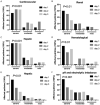Analysis of the correlation between the severity of neonatal hypoxic ischemic encephalopathy and multiple organ dysfunction
- PMID: 35173848
- PMCID: PMC8829617
Analysis of the correlation between the severity of neonatal hypoxic ischemic encephalopathy and multiple organ dysfunction
Abstract
Objective: To evaluate the hypoxic ischemic encephalopathy (HIE) and multiple organ dysfunction (MOD) in neonates and analyze the correlation between the two disorders.
Methods: From January 2018 to January 2020, infants with HIE who were born in our hospital at or above 37 weeks of gestation, and those with ischemic hypoxic encephalopathy at or above 2000 grams were selected as study subjects. HIE and MOD monitoring were performed for three days. HIE severity was graded according to reported scores including amplitude integrated EEG. Multiple organ dysfunction was also assessed. The correlation between neonatal hypoxic ischemic encephalopathy and multiple organ dysfunction was analyzed.
Results: Children with HIE were divided into three grades: mild, moderate and severe. There were statistically significant differences among the three groups in emergency caesarean section, Apgar 5 minutes, systemic hypothermia and neonatal mortality. Differences in MOD scores were found in three HIE stages per day from Day 1 to Day 3. Among children with mild HIE grading, the most common mildly affected organ systems are pH, electrolyte imbalance and liver system, and the least affected organs are kidney and blood systems. Among children with HIE grade of mild and severe, there was no significant difference in moderate-severe organ involvement, and the number of severely affected children was small.
Conclusion: With the increase of HIE severity, multi-organ involvement is aggravated. The organ involvement of HIE children with different degrees of severity is different.
Keywords: Neonatal hypoxic ischemic encephalopathy; multiple organ dysfunction.
AJTR Copyright © 2022.
Conflict of interest statement
None.
Figures




References
-
- Papazian O. Neonatal hypoxic-ischemic encephalopathy. Medicina (B Aires) 2018;78(Suppl 2):36–41. - PubMed
-
- Douglas-Escobar M, Weiss MD. Hypoxic-ischemic encephalopathy: a review for the clinician. JAMA Pediatr. 2015;169:397–403. - PubMed
-
- Silveira RC, Procianoy RS. Hypothermia therapy for newborns with hypoxic ischemic encephalopathy. J Pediatr (Rio J) 2015;91:S78–83. - PubMed
-
- Yildiz EP, Ekici B, Tatli B. Neonatal hypoxic ischemic encephalopathy: an update on disease pathogenesis and treatment. Expert Rev Neurother. 2017;17:449–459. - PubMed
-
- Glass HC. Hypoxic-ischemic encephalopathy and other neonatal encephalopathies. Continuum (Minneap Minn) 2018;24:57–71. - PubMed
LinkOut - more resources
Full Text Sources
